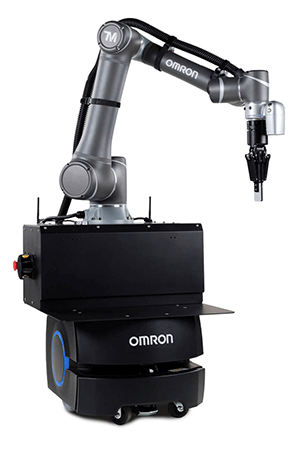

Together, shipping, receiving and storage account for less than half of all warehousing activity costs. The lion’s share of expenses – a whopping 55% – lies in order picking. Breaking down the various activities associated with order picking, we find that over 60% of the time is spent walking, with writing, searching, and picking tasks comprising the other 40%.
Given the data, it’s safe to say that automating the walking portion of an order picking operation will have a strong positive impact on overall warehouse efficiency. Omron Logistics strategic account manager, Yaqing Sun, recently discussed some strategies for using autonomous mobile robots (AMRs) for this purpose at the Automate 2022 show.
Strategy 1: Transporting items to employees (‘goods to person’)
By having an AMR autonomously move goods to a warehouse associate, you can reduce the amount of time that associate spends walking, which in turn reduces fatigue and generally improves work satisfaction. In addition, it improves traceability by automating the QR code scanning process.
Some potential downsides of this method include high upfront investment costs, relatively long integration and/or installation time, and the likelihood of infrastructure changes to the facility. Still, logistics facilities by and large find that the productivity benefits heavily outweigh the initial costs of deployment.
Strategy 2: Transporting items between zones (‘person to goods’)
This strategy involves breaking the warehouse into separate order picking zones, each of which will have a dedicated employee. Since a single order might involve picking from more than one zone, an autonomous mobile robot will move between the zones, stopping whenever an employee needs to retrieve a particular item.
Although each employee must still do some walking, having AMRs traverse the long distances between zones significantly reduces walking times. The main downside of this method is that employees must still scan items manually, so traceability isn’t fully automated.
Strategy 3: Transporting items to a robot (‘goods to robot’)
This method has the dual advantages of high accuracy and low dependence on labour availability, making it a good option for companies struggling to hire personnel. Minor downsides include high investment costs and the possibility of lower throughput relative to manual picking.
Nonetheless, collaborative robotic (cobot) technology is advancing by leaps and bounds, and solutions that connect an autonomous mobile robot with a cobot are going to just get more and more efficient. Furthermore, both AMRs and cobots can work around the clock with minimal downtime.
| Tel: | +27 11 579 2600 |
| Email: | [email protected] |
| www: | www.industrial.omron.co.za |
| Articles: | More information and articles about Omron Electronics |

© Technews Publishing (Pty) Ltd | All Rights Reserved